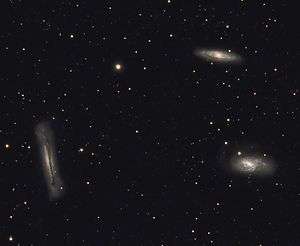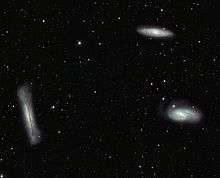Leo Triplet
| Leo Triplet | |
|---|---|
|
The Leo Triplet, with M65 (right top), M66 (right bottom) and NGC 3628 (left). North is to the left. | |
| Observation data (Epoch J2000) | |
| Constellation(s) | Leo |
| Right ascension | 11h 17m[1][2] |
| Declination | +13° 25′[1][2] |
| Brightest member | M66[1][2] |
| Number of galaxies | 3-5[1][2][3] |
| Other designations | |
|
M66 Group, Arp 317,[4] LGG 231,[1] NOGG P1 533,[2] NOGG P2 543[2] | |
| See also: Galaxy groups, Galaxy clusters, List of galaxy clusters | |
The Leo Triplet (also known as the M66 Group) is a small group of galaxies about 35 million light-years away[5] in the constellation Leo. This galaxy group consists of the spiral galaxies M65, M66, and NGC 3628.
Members
The table below lists galaxies that have been consistently identified as group members in the Nearby Galaxies Catalog,[3] the Lyons Groups of Galaxies (LGG) Catalog,[1] and the group lists created from the Nearby Optical Galaxy sample of Giuricin et al.[2]
Member list
| Name | Type[6] | R.A. (J2000)[6] | Dec. (J2000)[6] | Redshift (km/s)[6] | Apparent Magnitude[6] |
|---|---|---|---|---|---|
| M65 | SAB(rs)a | 11h 18m 56.0s | +13° 05′ 32″ | 807 ± 3 | 10.3 |
| M66 | SAB(s)b | 11h 20m 15.0s | +12° 59′ 30″ | 727 ± 3 | 9.7 |
| NGC 3628 | SAb pec | 11h 20m 17.0s | +13° 35′ 23″ | 843 ± 1 | 9.4 |
Additionally, some of the references cited above indicate that one or two other nearby galaxies may be group members. NGC 3593 is frequently but not consistently identified as a member of this group.
Nearby groups
The M96 Group is located physically near the Leo Triplet.[7] These two groups may actually be separate parts of a much larger group,[7] and some group identification algorithms actually identify the Leo Triplet as part of the M96 Group.[2][8]
Gallery
-

Leo Triplet amateur image
- ^ "VST Looks at the Leo Triplet — and Beyond". ESO Photo Release. Retrieved 27 July 2011.
See also
- NGC 5866 Group – another small group of galaxies
References
- 1 2 3 4 5 6 A. Garcia (1993). "General study of group membership. II – Determination of nearby groups". Astronomy and Astrophysics Supplement. 100: 47–90. Bibcode:1993A&AS..100...47G.
- 1 2 3 4 5 6 7 8 G. Giuricin; C. Marinoni; L. Ceriani; A. Pisani (2000). "Nearby Optical Galaxies: Selection of the Sample and Identification of Groups". Astrophysical Journal. 543 (1): 178–194. arXiv:astro-ph/0001140
 . Bibcode:2000ApJ...543..178G. doi:10.1086/317070.
. Bibcode:2000ApJ...543..178G. doi:10.1086/317070. - 1 2 R. B. Tully (1988). Nearby Galaxies Catalog. Cambridge: Cambridge University Press. ISBN 0-521-35299-1.
- ↑ H. Arp (1966). "Atlas of Peculiar Galaxies". Astrophysical Journal Supplement. 14: 1–20. Bibcode:1966ApJS...14....1A. doi:10.1086/190147.
- ↑ VST Looks at the Leo Triplet — and Beyond
- 1 2 3 4 5 "NASA/IPAC Extragalactic Database". Results for various galaxies. Retrieved 2006-10-24.
- 1 2 L. Ferrarese, H. C. Ford, J. Huchra, R. C. Kennicutt Jr., J. R. Mould, S. Sakai, W. L. Freedman, P. B. Stetson, B. F. Madore, B. K. Gibson, J. A. Graham, S. M. Hughes, G. D. Illingworth, D. D. Kelson, L. Macri, K. Sebo, N. A. Silbermann (2000). "A Database of Cepheid Distance Moduli and Tip of the Red Giant Branch, Globular Cluster Luminosity Function, Planetary Nebula Luminosity Function, and Surface Brightness Fluctuation Data Useful for Distance Determinations". Astrophysical Journal Supplement. 128 (2): 431–459. arXiv:astro-ph/9910501
 . Bibcode:2000ApJS..128..431F. doi:10.1086/313391.
. Bibcode:2000ApJS..128..431F. doi:10.1086/313391. - ↑ P. Fouque, E. Gourgoulhon, P. Chamaraux, G. Paturel; Gourgoulhon; Chamaraux; Paturel (1992). "Groups of galaxies within 80 Mpc. II – The catalogue of groups and group members". Astronomy and Astrophysics Supplement. 93: 211–233. Bibcode:1992A&AS...93..211F.
External links
- The Leo Triplett (M66 group)
- The Leo Triplet on WikiSky: DSS2, SDSS, GALEX, IRAS, Hydrogen α, X-Ray, Astrophoto, Sky Map, Articles and images
- Szymanek, Nik; Gray, Meghan. "M65 – Spiral Galaxy". Deep Sky Videos. Brady Haran.
Coordinates: ![]() 11h 17m 00s, +13° 25′ 00″
11h 17m 00s, +13° 25′ 00″

